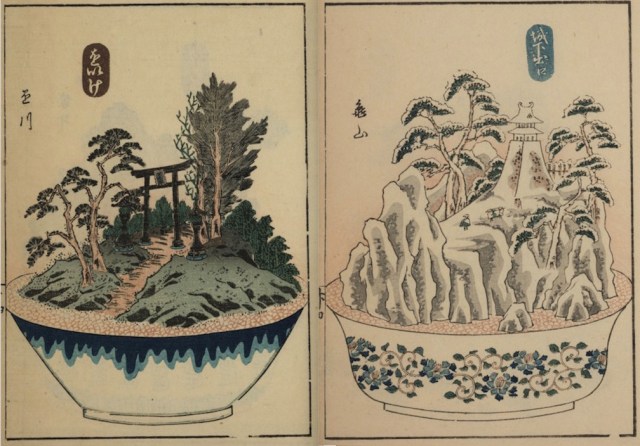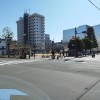The Tōkaidō is perhaps the most important road in Japan’s history. Built in the 17th century, it connected the country’s two powerhouses: it runs from Kyoto, the imperial capital, to Edo (now Tokyo), the seat of the Shogunate. As well as being an important political and trade route, depictions of the Tōkaidō in art in literature were abundant and popular.
The best-known of these is Utagawa Hiroshiges’s series of ukiyo-e woodcut prints, The Fifty-three Stations of the Tōkaidō. Ukiyo-e woodblock printing like this continued to flourish in Japan until the 19th century.
Less famous than Hiroshige is the relatively unknown ukiyo-e artist Utagawa Yoshishige, who produced his own prints of the 53 stations along the Tōkaido – by depicting each station in the form of a potted landscape.

 Japan’s oldest largetooth sawfish in captivity back on display in Mie Prefecture
Japan’s oldest largetooth sawfish in captivity back on display in Mie Prefecture Starbucks Japan ready to get Year of the Horse started with adorable drinkware and plushies【Pics】
Starbucks Japan ready to get Year of the Horse started with adorable drinkware and plushies【Pics】 Japanese security polearm maker’s takedown videos are crazy, products look crazy effective【Vids】
Japanese security polearm maker’s takedown videos are crazy, products look crazy effective【Vids】 Salmon sashimi noodles: Terrifying, mouthwatering, or both?【Photos】
Salmon sashimi noodles: Terrifying, mouthwatering, or both?【Photos】 Japan’s human washing machines will go on sale to general public, demos to be held in Tokyo
Japan’s human washing machines will go on sale to general public, demos to be held in Tokyo Photos of Complete Strangers: Japan’s new strange, and strangely compelling, capsule toys【Pics】
Photos of Complete Strangers: Japan’s new strange, and strangely compelling, capsule toys【Pics】 Japanese manhole covers become a hit with foreign tourists in off-the-beaten path Tokyo area
Japanese manhole covers become a hit with foreign tourists in off-the-beaten path Tokyo area Shikadamari: The Nara deer summer gathering phenomenon that baffles visitors every year
Shikadamari: The Nara deer summer gathering phenomenon that baffles visitors every year The mystery destination of the SoraNews24 end-of-year party left us speechless
The mystery destination of the SoraNews24 end-of-year party left us speechless More Than a Capsule Stay: Why Solo Travelers Choose “global cabin Yokohama Chinatown”
More Than a Capsule Stay: Why Solo Travelers Choose “global cabin Yokohama Chinatown” Lacquerware supplier to emperor of Japan and Pokémon team up for new tableware
Lacquerware supplier to emperor of Japan and Pokémon team up for new tableware Japan may add Japanese language proficiency, lifestyle classes to permanent foreign resident requirements
Japan may add Japanese language proficiency, lifestyle classes to permanent foreign resident requirements 7-Eleven Japan’s ramen-cooking robot whipped us up a bowl of noodles【Taste test】
7-Eleven Japan’s ramen-cooking robot whipped us up a bowl of noodles【Taste test】 Cyberpunk anime meets traditional culture in Ghost in the Shell gold leaf Japanese changing screens
Cyberpunk anime meets traditional culture in Ghost in the Shell gold leaf Japanese changing screens Disillusionment at Tsukiji’s tourist-target prices led us to a great ramen restaurant in Tokyo
Disillusionment at Tsukiji’s tourist-target prices led us to a great ramen restaurant in Tokyo 7 great places to see Mt. Fuji from without having to climb it
7 great places to see Mt. Fuji from without having to climb it Hello Kitty Choco Egg figures are an adorable trip through three periods of Japanese pop culture【Pics】
Hello Kitty Choco Egg figures are an adorable trip through three periods of Japanese pop culture【Pics】 Starbucks Japan releases new zodiac chilled cup drink for 2026
Starbucks Japan releases new zodiac chilled cup drink for 2026 Japan’s otoshidama tradition of giving kids money at New Year’s gets a social welfare upgrade
Japan’s otoshidama tradition of giving kids money at New Year’s gets a social welfare upgrade 7-Eleven Japan starts new temporary luggage storage service in over 300 branches
7-Eleven Japan starts new temporary luggage storage service in over 300 branches Starbucks teams up with 166-year-old Kyoto doll maker for Year of the Horse decorations【Photos】
Starbucks teams up with 166-year-old Kyoto doll maker for Year of the Horse decorations【Photos】 Tokyo considering law requiring more trash cans following litter increase in heavily touristed area
Tokyo considering law requiring more trash cans following litter increase in heavily touristed area Tokyo’s Tsukiji sushi neighborhood asks tour groups to stay away for the rest of the month
Tokyo’s Tsukiji sushi neighborhood asks tour groups to stay away for the rest of the month Nintendo’s Kirby now delivering orders at Kura Sushi restaurants, but not in Japan
Nintendo’s Kirby now delivering orders at Kura Sushi restaurants, but not in Japan Tokyo event lets you travel back in time, for free, to celebrate 100 years since Showa era start
Tokyo event lets you travel back in time, for free, to celebrate 100 years since Showa era start Sanrio theme park in Japan announces plans to expand into a Sanrio resort
Sanrio theme park in Japan announces plans to expand into a Sanrio resort Stamina-destroying “Paralysis Noodles” are Tokyo’s newest over-the-top ramen innovation
Stamina-destroying “Paralysis Noodles” are Tokyo’s newest over-the-top ramen innovation Survey asks foreign tourists what bothered them in Japan, more than half gave same answer
Survey asks foreign tourists what bothered them in Japan, more than half gave same answer Japan’s deadliest food claims more victims, but why do people keep eating it for New Year’s?
Japan’s deadliest food claims more victims, but why do people keep eating it for New Year’s? We deeply regret going into this tunnel on our walk in the mountains of Japan
We deeply regret going into this tunnel on our walk in the mountains of Japan Studio Ghibli releases Kodama forest spirits from Princess Mononoke to light up your home
Studio Ghibli releases Kodama forest spirits from Princess Mononoke to light up your home Major Japanese hotel chain says reservations via overseas booking sites may not be valid
Major Japanese hotel chain says reservations via overseas booking sites may not be valid Put sesame oil in your coffee? Japanese maker says it’s the best way to start your day【Taste test】
Put sesame oil in your coffee? Japanese maker says it’s the best way to start your day【Taste test】 No more using real katana for tourism activities, Japan’s National Police Agency says
No more using real katana for tourism activities, Japan’s National Police Agency says Starbucks Japan reveals new sakura drinkware collection, inspired by evening cherry blossoms
Starbucks Japan reveals new sakura drinkware collection, inspired by evening cherry blossoms Updated cherry blossom forecast shows extra-long sakura season for Japan this year
Updated cherry blossom forecast shows extra-long sakura season for Japan this year Photos of Complete Strangers: Japan’s new strange, and strangely compelling, capsule toys【Pics】
Photos of Complete Strangers: Japan’s new strange, and strangely compelling, capsule toys【Pics】 Japanese manhole covers become a hit with foreign tourists in off-the-beaten path Tokyo area
Japanese manhole covers become a hit with foreign tourists in off-the-beaten path Tokyo area Shikadamari: The Nara deer summer gathering phenomenon that baffles visitors every year
Shikadamari: The Nara deer summer gathering phenomenon that baffles visitors every year The mystery destination of the SoraNews24 end-of-year party left us speechless
The mystery destination of the SoraNews24 end-of-year party left us speechless More Than a Capsule Stay: Why Solo Travelers Choose “global cabin Yokohama Chinatown”
More Than a Capsule Stay: Why Solo Travelers Choose “global cabin Yokohama Chinatown” Princesses, fruits, and blacksmiths: Study reveals the 30 most unusual family names in Japan
Princesses, fruits, and blacksmiths: Study reveals the 30 most unusual family names in Japan Hello Kitty Choco Egg figures are an adorable trip through three periods of Japanese pop culture【Pics】
Hello Kitty Choco Egg figures are an adorable trip through three periods of Japanese pop culture【Pics】 The results are in from our one million-yen stack of Japanese lottery tickets! So, are we rich?
The results are in from our one million-yen stack of Japanese lottery tickets! So, are we rich? Best all-you-can-eat okonomiyaki in Japan? Restaurant chain serves up a feast for under $14
Best all-you-can-eat okonomiyaki in Japan? Restaurant chain serves up a feast for under $14 “Too sexy!” New Final Fantasy’s hunky male lead has his revealing costume toned down
“Too sexy!” New Final Fantasy’s hunky male lead has his revealing costume toned down Totoro stamp collection lets you add adorable Ghibli touches to cards and letters【Photos】
Totoro stamp collection lets you add adorable Ghibli touches to cards and letters【Photos】 This lucky box stuffed with Tokyo souvenirs is sold online, but you still have to fight for it!
This lucky box stuffed with Tokyo souvenirs is sold online, but you still have to fight for it!